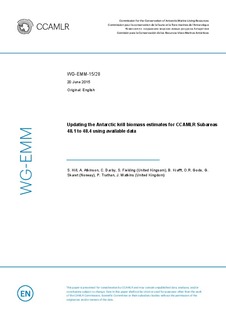| dc.description.abstract | We present a novel index of Antarctic krill biomass in CCAMLR subareas 48.1 to 48.4,
based on data from scientific nets and covering the years between 2000 and 2011. The annual biomass
variation was significant (CV=73%) but no systematic change in krill biomass was evident during the
period. The index also suggests that realised exploitation rates were below 0.5% (i.e. catch was <0.5%
of biomass) and that the potential exploitation rates implied by the operational catch limit (the trigger
level) were below 2% during this period. These exploitation rates are much lower than the
precautionary yield estimate for the krill fishery (which is 9.3%). Biomass indices from local scale
acoustic surveys also suggest that exploitation rates are low and that there is no evidence of a
systematic change in the krill stock. This evidence suggests that the trigger level is a highly
precautionary operational catch limit which is currently appropriate for achieving the conservation
criteria for the krill stock. It also suggests that the catch levels seen in the first decade of the 21st
century are unlikely to have adversely impacted the krill stock. Nonetheless the Commission also
needs to manage the risk of adverse impacts on dependent and related populations which might occur
if fishing is concentrated in sensitive areas. Advances are needed to improve management of krill
fisheries to manage these risks and to ensure that management is robust to the potential impacts of
climate change. We suggest that frequent assessment of the krill stock, at scales relevant to the
Commission’s conservation objectives, is a prerequisite for such advances. The most effective means
to achieve this is likely to be through increased use of fishing vessels to collect data, while
maintaining current time series | nb_NO |
